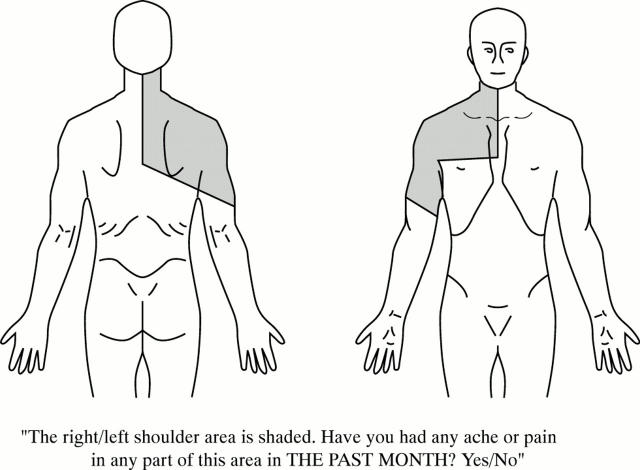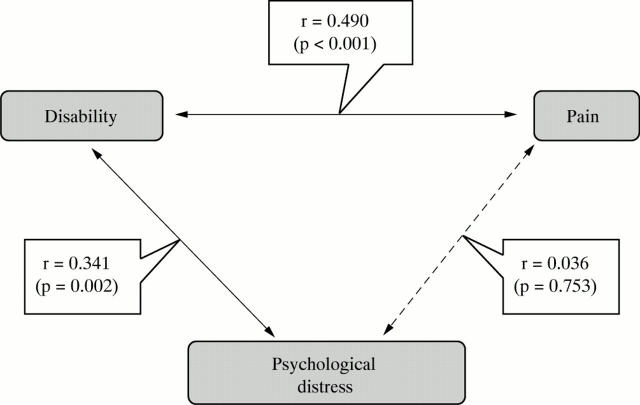Abstract
Objectives: To investigate two questions in a community based population of people with chronic shoulder pain. Firstly, does chronic pain lead to impaired psychological health over time? Secondly, how does restriction of daily activity influence pain perception and psychological health?
Methods: Two postal surveys, two years apart, were carried out to identify a group of subjects with chronic shoulder pain. The first survey was sent to a random sample of adults (n=40026) registered with a primary care practice, and included a pain manikin, demographic information, and the Hospital Anxiety and Depression scale (HAD). The second survey was sent to those subjects who reported unilateral shoulder region pain in the first survey and it included a shoulder-specific disability scale, pain severity score, and the HAD.
Results: 2606 (65.1%) people responded to the initial survey. Of these, 304 (11.7%) reported unilateral shoulder region pain at baseline. In the subsequent survey, there were 234 responders (83.3% adjusted response): 142 of these reported shoulder pain and formed our study group of "subjects with chronic shoulder pain". Within this group there was no significant change in psychological distress scores between baseline and follow up. Both the disability score and psychological distress scores correlated significantly with pain severity (disability v pain r=0.536, p<0.001; psychological distress v pain r=0.269, p=0.002). When the correlation between disability and pain severity was corrected for possible confounders, it remained significant (r=0.490, p<0.001). This was not the case for the correlation between psychological distress and pain (p>0.05). Disability was significantly correlated with psychological distress on univariate (r=0.445, p<0.001) and multivariate analysis (r=0.341, p=0.002).
Conclusion: In those with chronic shoulder pain the relation between pain and psychological health seems to be linked to disability. Psychological distress was not explained by persistent pain itself.
Full Text
The Full Text of this article is available as a PDF (115.4 KB).
Figure 1 .
Survey definition of shoulder region pain.
Figure 2 .
Results of the multivariate analysis of the relationship between pain, disability, and psychological distress.
Selected References
These references are in PubMed. This may not be the complete list of references from this article.
- Albrecht G. L., Devlieger P. J. The disability paradox: high quality of life against all odds. Soc Sci Med. 1999 Apr;48(8):977–988. doi: 10.1016/s0277-9536(98)00411-0. [DOI] [PubMed] [Google Scholar]
- Badley E. M., Tennant A. Changing profile of joint disorders with age: findings from a postal survey of the population of Calderdale, West Yorkshire, United Kingdom. Ann Rheum Dis. 1992 Mar;51(3):366–371. doi: 10.1136/ard.51.3.366. [DOI] [PMC free article] [PubMed] [Google Scholar]
- Bjelle A. Epidemiology of shoulder problems. Baillieres Clin Rheumatol. 1989 Dec;3(3):437–451. doi: 10.1016/s0950-3579(89)80003-2. [DOI] [PubMed] [Google Scholar]
- Chard M. D., Hazleman R., Hazleman B. L., King R. H., Reiss B. B. Shoulder disorders in the elderly: a community survey. Arthritis Rheum. 1991 Jun;34(6):766–769. doi: 10.1002/art.1780340619. [DOI] [PubMed] [Google Scholar]
- Croft P., Pope D., Silman A. The clinical course of shoulder pain: prospective cohort study in primary care. Primary Care Rheumatology Society Shoulder Study Group. BMJ. 1996 Sep 7;313(7057):601–602. doi: 10.1136/bmj.313.7057.601. [DOI] [PMC free article] [PubMed] [Google Scholar]
- Croft P., Pope D., Zonca M., O'Neill T., Silman A. Measurement of shoulder related disability: results of a validation study. Ann Rheum Dis. 1994 Aug;53(8):525–528. doi: 10.1136/ard.53.8.525. [DOI] [PMC free article] [PubMed] [Google Scholar]
- Hasvold T., Johnsen R. Headache and neck or shoulder pain--frequent and disabling complaints in the general population. Scand J Prim Health Care. 1993 Sep;11(3):219–224. doi: 10.3109/02813439308994834. [DOI] [PubMed] [Google Scholar]
- Herrmann C. International experiences with the Hospital Anxiety and Depression Scale--a review of validation data and clinical results. J Psychosom Res. 1997 Jan;42(1):17–41. doi: 10.1016/s0022-3999(96)00216-4. [DOI] [PubMed] [Google Scholar]
- Linton S. J. An overview of psychosocial and behavioral factors in neck-and-shoulder pain. Scand J Rehabil Med Suppl. 1995;32:67–77. [PubMed] [Google Scholar]
- Macfarlane G. J., Hunt I. M., Silman A. J. Predictors of chronic shoulder pain: a population based prospective study. J Rheumatol. 1998 Aug;25(8):1612–1615. [PubMed] [Google Scholar]
- Pope D. P., Croft P. R., Pritchard C. M., Silman A. J. Prevalence of shoulder pain in the community: the influence of case definition. Ann Rheum Dis. 1997 May;56(5):308–312. doi: 10.1136/ard.56.5.308. [DOI] [PMC free article] [PubMed] [Google Scholar]
- Spinhoven P., Ormel J., Sloekers P. P., Kempen G. I., Speckens A. E., Van Hemert A. M. A validation study of the Hospital Anxiety and Depression Scale (HADS) in different groups of Dutch subjects. Psychol Med. 1997 Mar;27(2):363–370. doi: 10.1017/s0033291796004382. [DOI] [PubMed] [Google Scholar]
- Vecchio P. C., Kavanagh R. T., Hazleman B. L., King R. H. Community survey of shoulder disorders in the elderly to assess the natural history and effects of treatment. Ann Rheum Dis. 1995 Feb;54(2):152–154. doi: 10.1136/ard.54.2.152. [DOI] [PMC free article] [PubMed] [Google Scholar]
- Von Korff M., Deyo R. A., Cherkin D., Barlow W. Back pain in primary care. Outcomes at 1 year. Spine (Phila Pa 1976) 1993 Jun 1;18(7):855–862. doi: 10.1097/00007632-199306000-00008. [DOI] [PubMed] [Google Scholar]
- Von Korff M., Ormel J., Keefe F. J., Dworkin S. F. Grading the severity of chronic pain. Pain. 1992 Aug;50(2):133–149. doi: 10.1016/0304-3959(92)90154-4. [DOI] [PubMed] [Google Scholar]
- Zigmond A. S., Snaith R. P. The hospital anxiety and depression scale. Acta Psychiatr Scand. 1983 Jun;67(6):361–370. doi: 10.1111/j.1600-0447.1983.tb09716.x. [DOI] [PubMed] [Google Scholar]




